|
|
|
|
Late Entries to a Survey of Bestiaries
The staff of the Poison Pie Publishing House assembled a survey of one hundred bestiaries, posting an entry on their blog for each day from June 1, 2016 to September 8, 2016. When they were done, there were additional bestiaries that they did not want to omit entirely. This page lists latecomers to the survey added in 2022.
|
|
|
|
|
January 1, 2022
Sea Monsters
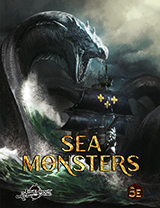 authors: Miguel Colon et al.
authors: Miguel Colon et al.
interior artists: Simon Aan et al.
cover artist: uncredited
publisher: Legendary Games
publication date: June, 2021
cover: softcover
number of pages: 80
ISBN-10: 1-955320-02-0
ISBN-13: 978-1-955320-02-3
catalog number: LGP454HO045E
description: This bestiary contains descriptions of more than 60 maritime creatures. It is compatible with the 5th edition of the Dungeons & Dragons Role Playing Game.
Our featured entry from this bestiary is the Scylla.
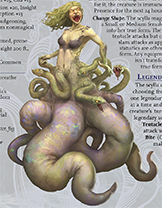 The scylla is one of the more nightmarish aberrations to
blight the mortal world, horrifying creatures with the upper
body of a beautiful woman but a lower body of snapping wolf
or serpent heads and writhing tentcles. Conflicting tales of
her origins abound, from demonic flesh-crafting and arcane
experiments to a divine curse handed down by a vengeful
deity. The most popular stories cast the first scylla as the
monstrous spawn of a union between a mortal and a god.
Whatever the case, scyllas are fortunately quite rare, enough
so that many consider them nothing more than tall tales told
by sailors deep in their cups.
The scylla is one of the more nightmarish aberrations to
blight the mortal world, horrifying creatures with the upper
body of a beautiful woman but a lower body of snapping wolf
or serpent heads and writhing tentcles. Conflicting tales of
her origins abound, from demonic flesh-crafting and arcane
experiments to a divine curse handed down by a vengeful
deity. The most popular stories cast the first scylla as the
monstrous spawn of a union between a mortal and a god.
Whatever the case, scyllas are fortunately quite rare, enough
so that many consider them nothing more than tall tales told
by sailors deep in their cups.
|
|
|
|
|
February 5, 2022
Mythos Monsters
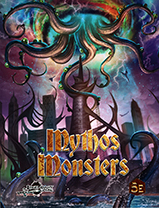 authors: Michael "solomani" Mifsud et al.
authors: Michael "solomani" Mifsud et al.
interior artists: Simon Aan et al.
cover artist: uncredited
publisher: Legendary Games
publication date: June, 2021
cover: softcover
number of pages: 74
ISBN-10: 1-955320-00-4
ISBN-13: 978-1-955320-00-9
catalog number: LGP454HO045E
description: This bestiary contains descriptions of more than 40 eldritch abominations. It is compatible with the 5th edition of the Dungeons & Dragons Role Playing Game.
Our featured entry from this bestiary is the moon-beast.
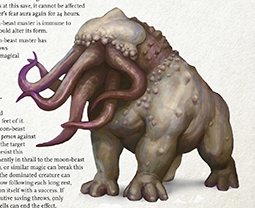 Moon-beasts have no voice or eyes, yet they "see" more than
most and can project their thoughts into the very minds of
those they wish to communicate with. These monstrosities
hail not from any physical moon, but rather from the shared
satellite of all slumbering minds in the Dimension of Dream
beyond the wall of sleep. Here, the moon-beasts raise stone
cities on the oily shores of night-black seas found upon the
dark side of the dreaming moon, from which they launch
long, dark galleys crewed by not-quite-human slaves that sail
through the void of space down to the seas of the Dimension
of Dream to seek new slaves and stranger, more sinister wares.
A moon-beast is 9 feet long and weighs 800 pounds.
Moon-beasts have no voice or eyes, yet they "see" more than
most and can project their thoughts into the very minds of
those they wish to communicate with. These monstrosities
hail not from any physical moon, but rather from the shared
satellite of all slumbering minds in the Dimension of Dream
beyond the wall of sleep. Here, the moon-beasts raise stone
cities on the oily shores of night-black seas found upon the
dark side of the dreaming moon, from which they launch
long, dark galleys crewed by not-quite-human slaves that sail
through the void of space down to the seas of the Dimension
of Dream to seek new slaves and stranger, more sinister wares.
A moon-beast is 9 feet long and weighs 800 pounds.
Slave-Hunters. Moon-beasts are slavers, first and foremost.
They use their magic to curb rebellion or to quickly gain
minions, but much prefer using physical and mental
regimens of torment and reconditioning to break the spirit
of their captives. They often work with the denizens of Leng, a
metaphysically nearby dimension of nightmare and madness,
although as often as not these planar neighbors serve the
moon-beasts merely as slaves.
|
|
|
|
|
March 5, 2022
Asian Monsters
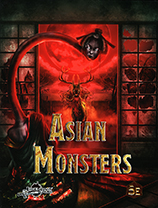 authors: Miguel Colon et al.
authors: Miguel Colon et al.
interior artists: Bruno Balixa et al.
cover artist: uncredited
publisher: Legendary Games
publication date: July, 2021
cover: softcover
number of pages: 112
ISBN-10: 1-955320-06-3
ISBN-13: 978-1-955320-06-1
catalog number: LGP499FE015E
description: This bestiary contains descriptions of more than 90 incredible creatures drawn from the myths and legends of Asia. It is compatible with the 5th edition of the Dungeons & Dragons Role Playing Game.
Our featured entry from this bestiary is the quyrua.
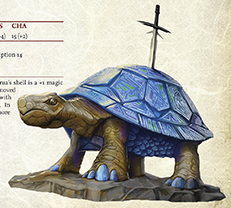 Quyrua are guardians of riverways and inland settlements
bordering rivers or lakes. They resemble an oversized turtle
with a brilliant shell of vibrant color, though the shell’s most
distinctive feature is that it is punctured by an impressive
weapon. The quyrua’s eyes show a measure of sentience and
the glimmer of eternal patience. A quyrua is typically about 12
feet long and weighs around 2,200 pounds.
Quyrua are guardians of riverways and inland settlements
bordering rivers or lakes. They resemble an oversized turtle
with a brilliant shell of vibrant color, though the shell’s most
distinctive feature is that it is punctured by an impressive
weapon. The quyrua’s eyes show a measure of sentience and
the glimmer of eternal patience. A quyrua is typically about 12
feet long and weighs around 2,200 pounds.
Heroic Origin. Quyrua often form the basis of regional
legends, with the weapons embedded in their back being
an implement used by some historic figure. These magical
creatures are created when such a legendary (possibly mythic)
hero embeds their weapon in the back of a venerable tortoise.
The tortoise is then given a spark of magical sentience, blessed
by a sponsoring power—most often a deity affiliated with the
hero.
Bearers of Legacy. The hero departs to unknown places after
giving the quyrua its final instructions, which often consist of
a required quest or traits to be found in a suitable heir for the
weapon. The quyrua does its best to ensure they live up to the
legacy of their creator, ready to gift the weapon they carry onto
one capable of upholding the weapon’s legacy. Such cases are
obviously rare, for a quyrua giving up its embedded weapon
also succumbs to a quick (but peaceful) death.
|
|
|
|
|
April 2, 2022
The Dark Crystal Bestiary
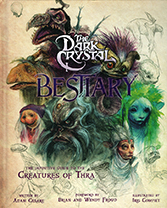 author: Adam Cesare
author: Adam Cesare
interior artist: Iris Compiet
cover artist: Iris Compiet
publisher: Titan Books
publication date: 2020
cover: hardcover
number of pages: 168
ISBN-10: 1-78909-620-0
ISBN-13: 978-1-78909-620-0
description: This codex contains 126 entries describing denizens of the world of Dark Crystal. It is not associated with a Role Playing Game.
Our featured entry from this bestiary is the gruenak.
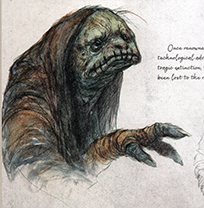 Possessing long arms, big mouths, gray skin, and flat faces, Gruenaks were one of Thra's most prominent sentient species during the Age of Harmony. With the arrival of the Skeksis at the beginning of the Age of Division, the Gruenaks found themselves facing a powerful enemy.
Possessing long arms, big mouths, gray skin, and flat faces, Gruenaks were one of Thra's most prominent sentient species during the Age of Harmony. With the arrival of the Skeksis at the beginning of the Age of Division, the Gruenaks found themselves facing a powerful enemy.
Ultimately, the Skeksis destroyed all but two Gruenaks. This unlucky pair was enslaved at the Castle of the Crystal and ahd their lips sewn shut so they could not share the cruelty of the Skeksis with others. skekTek took the corpse of the final Gruenak and spliced it with a fallen Arathim in order to engineer the first Garthim warrior.
Once renowned for their early technological advances, following their tragic extinction, Gruenak culture has been lost to the ravages of time.
|
|
|
|
|
May 7, 2022
Book of the Dead (Pathfinder Second Edition)
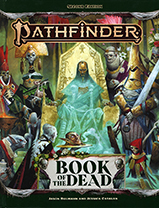 authors: Jason Bulmahn and Jessica Catalan
authors: Jason Bulmahn and Jessica Catalan
interior artists: Shah Adams et al.
cover artist: Wayne Reynolds
publisher: Paizo
publication date: 2022
cover: hardcover
number of pages: 224
ISBN-10: 1-64078-401-2
ISBN-13: 978-1-64078-401-7
description: This book contains lore of assorted types regarding the undead. Of interest to this survey, Chapter 3, which runs one hundred pages, contains descriptions of over fifty kinds of undead. This book is compatible with the Pathfinder Second Edition Role Playing Game.
Our featured entry from this bestiary is the little man of the woods.
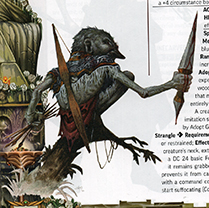 A murdered man left unburied in the wilds might return as a being called
a "little man in the woods," his decayed corpse shriveling until it shrinks
to the size of a child. Denied the respect of a burial that would smooth his
spirit's transition to the afterlife, he is unable to leave the mortal plane and
enter the realm of the spirits. Forgotten, lost, and miserable, suffering from
unbearable hunger and cold, the little man in the woods is desperate to
return to his mortal home and be laid to rest properly.
A murdered man left unburied in the wilds might return as a being called
a "little man in the woods," his decayed corpse shriveling until it shrinks
to the size of a child. Denied the respect of a burial that would smooth his
spirit's transition to the afterlife, he is unable to leave the mortal plane and
enter the realm of the spirits. Forgotten, lost, and miserable, suffering from
unbearable hunger and cold, the little man in the woods is desperate to
return to his mortal home and be laid to rest properly.
Despite his understandable motives, the little man in the woods has
degenerated into a foul, twisted creature. He deceives travelers with plaintive
cries then begs them to lead him to a home he barely recalls. He strangles
all who can't or won't aid him, including those who lead him to the wrong
home or otherwise delay his journey.
The little man in the woods lays his victims' bodies out in the wilds,
leaving the corpse unburied and exposed. He guards these rotting corpses
over years as they shrivel and decay, until each one rises as another little
man in the woods. Like any of the actions he has been compelled to perform,
creating more of his kind brings the little man in the woods no pleasure.
|
|
|
|
|
June 4, 2022
Monsters of the Multiverse
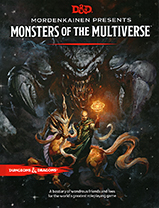 lead designer: Jeremy Crawford
lead designer: Jeremy Crawford
interior artists Dave Allsop et al.
cover artists: Grzegorz Rutkowski
publisher: Wizards of the Coast
publication date: 2022
cover: hardcover
number of pages: 288
ISBN-10: 0-7869-6787-0
ISBN-13: 978-0-7869-6787-2
description: This book contains over 250 creatures and over 30 race options. This book is compatible with the 5th edition of the Dungeons & Dragons Role Playing Game. As a note, this book is a revision of content that originally appeared in the books Volo's Guide to Monsters (2016), Mordenkainen's Tome of Foes (2018), Princes of the Apocalypse (2015), Eberron: Rising from the Last War (2019) & Mythic Odysseys of Theros (2020).
Our featured entry from this bestiary is the mindwitness.
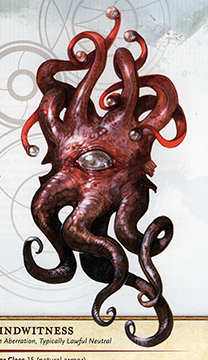 If a beholder is stunned and brought to the brine pool of an elder brain, the beholder can be converted into a mindwitness. This alters some of its eye rays and transforms four of its eyestalks into tentacles similar to a mind flayer's. The mindwitness is psychically imprinted with devotion to the elder brain and submission to illithid commands.
If a beholder is stunned and brought to the brine pool of an elder brain, the beholder can be converted into a mindwitness. This alters some of its eye rays and transforms four of its eyestalks into tentacles similar to a mind flayer's. The mindwitness is psychically imprinted with devotion to the elder brain and submission to illithid commands.
A mindwitness's primary function is to improve telepathic communication in a mind flayer colony. A creature in telepathic communication with a mindwitness can converse through it to as many as seven other creatures the mindwitness can see, rapidly disseminating commands and other information.
If separated from its illithid masters, a mindwitness seeks out other telepathic creatures to tell it
what to do. Mindwitnesses have been known to ally with flumphs and planar beings such as demons, shifting their worldview and alignment to match those of their new masters.
|
|
|
|
|
July 2, 2022
Jim Henson's Labyrinth Bestiary
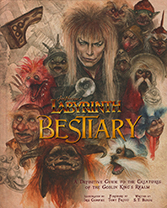 author: S.T. Bende
author: S.T. Bende
interior artist: Iris Compiet
cover artist: Iris Compiet
publisher: Insight Editions
publication date: 2022
cover: hardcover
number of pages: 160
ISBN-10: 1-64722-474-8
ISBN-13: 978-1-64722-474-5
description: This volume contains more than 40 entries describing denizens of the world of the Labyrinth. It is not associated with a Role Playing Game.
Our featured entry from this bestiary is Ludo.
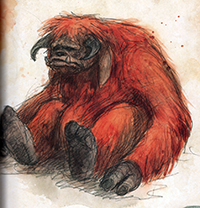 Loyal, strong and fiercely protective, Ludo stnds by his allies in good times and bad. This devoted companion escorts Sarah through her trials within the labyrinth—seeing her safely through the Bog of Eternal Stench and protecting her from the perils of the Goblin City. The rusty-haired creature doesn't shrink from the Goblin King's threats. Rather, he declares his fealty to his friends and fights for their freedom. Through his steadfast commitment, Ludo shows his companions that he will support them through any ordeal—no matter how dangerous.
Loyal, strong and fiercely protective, Ludo stnds by his allies in good times and bad. This devoted companion escorts Sarah through her trials within the labyrinth—seeing her safely through the Bog of Eternal Stench and protecting her from the perils of the Goblin City. The rusty-haired creature doesn't shrink from the Goblin King's threats. Rather, he declares his fealty to his friends and fights for their freedom. Through his steadfast commitment, Ludo shows his companions that he will support them through any ordeal—no matter how dangerous.
|
|
|
|
|
August 6, 2022
Latin American Monsters
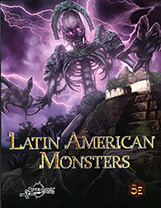 authors: Miguel Colon et al.
authors: Miguel Colon et al.
interior artists: Gonzalo Apestegui et al.
cover artist: uncredited
publisher: Legendary Games
publication date: June, 2022
cover: softcover
number of pages: 118
ISBN-10: 1-955320-09-8
ISBN-13: 978-1-955320-09-2
catalog number: LGP508LA015E
description: This bestiary contains descriptions of more than 120 incredible creatures drawn from the myths and legends of Latin America. It is compatible with the 5th edition of the Dungeons & Dragons Role Playing Game.
Our featured entry from this bestiary is the qasoǵonaǵa.
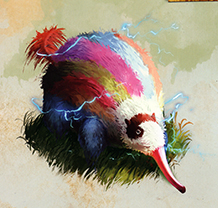 A qasoǵonaǵa is a mythical celestial creature that sometimes
falls from the heavens in times of need. In its true form, it
resembles a rainbow-colored anteater with an especially long
snout. It can take humanoid shape as necessary, especially
if trying to sense the goodness in the hearts of others. It is
generally nice, and not especially judgemental unless it is
witness to an evil heart or evil acts.
A qasoǵonaǵa is a mythical celestial creature that sometimes
falls from the heavens in times of need. In its true form, it
resembles a rainbow-colored anteater with an especially long
snout. It can take humanoid shape as necessary, especially
if trying to sense the goodness in the hearts of others. It is
generally nice, and not especially judgemental unless it is
witness to an evil heart or evil acts.
Eager to return to its native plane, it seeks the help of mortal
creatures through the creation of a ritualistic bonfire. If performed
properly, the qasoǵonaǵa can use the smoke to rise, eventually
returning to its home in the Outer Planes. It is said that those who
help the qasoǵonaǵa return to its plane are sometimes gifted with
druidic magic, or the lands they inhabit with bounty and rainfall.
The qasoǵonaǵa is a master of weather and uses its gifts to help
others. Only if pressed to fight will it unleash its unbridled fury.
|
|
|
|
|
September 3, 2022
Inventorum Natura: The Expedition Journal of Pliny the Elder
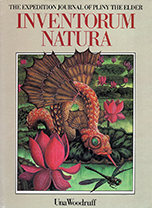 author: Una Woodruff
author: Una Woodruff
interior artist: Una Woodruff
cover artist: Una Woodruff
publisher: Paper Tiger
publication date: 1979
cover: softcover
number of pages: 126
ISBN-10: 0-905895-25-8
ISBN-13: 978-0-905895-25-3
description: This bestiary has two titles, including the one given above that appears on the cover as well as "Inventorum Natura: The Wonderful Voyage of Pliny" on the title page. The volume contains about fifty entries, some of which are maps of various regions.
Our featured entry from this bestiary is the man-eating plant.
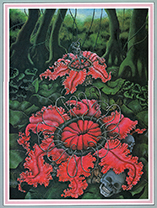 DE HERBIS ANIMALIBUS VESCENTIBUS
DE HERBIS ANIMALIBUS VESCENTIBUS
Aliquot herbarum ungues corniculaque sicut polypi
bracchia habent, ut lacertas, aves, et talia parva
animalia quibus vescentur implicent. est et herba
circa septem cubitorum crassitudine, quae validissima
bracchia habens et magna animalia praedam suam
facere solet. quibus incolae hostiam humanam
immolant, ut numina deorum silvae placent.*
Flesh-Eating Plants
Some of the plants have claws and tentacles in
order to ensnare lizards, birds and small creatures
which they feed upon. There is a plant
some seven cubits in diameter with very strong
tentacles which preys on large animals. The
natives make human sacrifices to them so as to
placate the spirits and gods of the forest.*
*Note: The exact wording of this is uncertain due to the
condition of the manuscript. An alternative reading could
be 'The natives present strangers to them (the plants) as
they believe them to be the gods of the forest: (qui bus
incolae hospites inducunt, quia creditur silvae deos esse.)
|
|
|
|
|
October 1, 2022
A Natural History of the Unnatural World
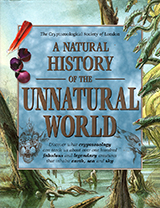 author: Joel Levy
author: Joel Levy
art editor: Simon Daley
cover artist: Nicholas Harris
publisher: St. Martin's Press
publication date: 1999
cover: harcover w/ dustjacket
number of pages: 224
ISBN-10: 0-312-20703-4
ISBN-13: 978-0-312-20703-8
description: Thia volume contains more than seventy entries of unnatural beasts ranging from the Loch Ness Monster to the unicorn.
Our featured entry from this bestiary is the caladrius.
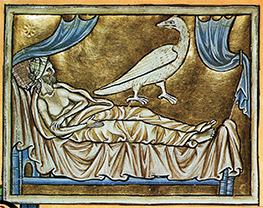 Of purest white is the noble caladrius that the ancients called an albinus for it hath no colour nor blackness either, not in its beak, nor in its wings, nor in its tail. This is truly the bird of Kings, and of a time was most welcome in the courts of all the Royal houses of Europe, for it hath the power to divine sickness, yea and to cure it. Even jaundice can it cure, nor is blindness any impediment to it. In form it is like unto a crow, but being somewhat larger, and of a solitary nature, not given to making its home in Rookery nor where there are others of its kind, it is passing rare and few in number. And where the gluttonous Crow will eat of any meat or matter, the caladrius is most particular in its habits, partaking only of those morsels such as would grace a King's table. Whereof there are many who do say that were the Royal courts to bar their doors agin the noble bird it would surely perish.
Of purest white is the noble caladrius that the ancients called an albinus for it hath no colour nor blackness either, not in its beak, nor in its wings, nor in its tail. This is truly the bird of Kings, and of a time was most welcome in the courts of all the Royal houses of Europe, for it hath the power to divine sickness, yea and to cure it. Even jaundice can it cure, nor is blindness any impediment to it. In form it is like unto a crow, but being somewhat larger, and of a solitary nature, not given to making its home in Rookery nor where there are others of its kind, it is passing rare and few in number. And where the gluttonous Crow will eat of any meat or matter, the caladrius is most particular in its habits, partaking only of those morsels such as would grace a King's table. Whereof there are many who do say that were the Royal courts to bar their doors agin the noble bird it would surely perish.
The caladrius is like unto Christ, who turneth his face from those who reject him but takes upon himself the sins of others. For if a man be sick, this sage bird can see the illness and all its course. If it doth turn away its face, then the man be fated to a certain death, but if he can be healed then the caladrius will draw the sickness into its own self and fly up to the heavens. Here the sun doth burn away the sickness and disperse it through the air.
|
|
|
|
|
November 5, 2022
Les Animaux Fantastiques
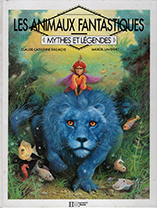 author: Claude-Catherine Ragache
author: Claude-Catherine Ragache
artist: Marcel Laverdet
cover artist: Marcel Laverdet
publisher: Hachtte Jeunesse
publication date: 1991
cover: harcover
number of pages: 48
ISBN-10: 2-01-016039-8
ISBN-13: 978-2-01-016039-4
description: This volume contains descriptions of about thirty-six fantastic beasts from around the world. It is written in French.
Our featured entry from this bestiary is the boongurunguru of the Solomon Islands.
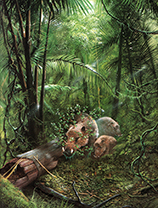 Ce jourl-là, Basania était trè fier, car son
père l'avait envoyé seul dans l'épaisse forêt
qui entourait le village. "Prends cette
machette, lui avait-il dit, et va couper des
palmes pour réparer le toit de notre hutte. Tu
es maintenant assez grand pour faire ce travail !"
Ce jourl-là, Basania était trè fier, car son
père l'avait envoyé seul dans l'épaisse forêt
qui entourait le village. "Prends cette
machette, lui avait-il dit, et va couper des
palmes pour réparer le toit de notre hutte. Tu
es maintenant assez grand pour faire ce travail !"
En peu de temps, Basania récolta une grosse brassée de
palmes. Il choisissait les plus grands arbres et s'amusait à
grimper jusqu'aux premières branches. D'en haut, il
apercevait son village, où ses parents et ses frères
semblaient tout petits. Avant de redescendre, il tranchait
d'un coup sec deux où trois palmes et regardait bien où
elles tombaient pour les retrouver ensuite. La végétation
etait si touffue ...
Peu à peu, Basania sentit la fatigue le gagner. La
machette était lourde et son bras lui faisait mal : il était
temps de rentrer. Il repéra un dernier arbre, se hissa
jusqu 'au so mm et, et stupeur ... ne vit pas le village ! Il
avait beau toumer ses yeux de tous côtés, il n'apercevait
rien, pas même une trace de fumée ! Il était pourtant sûr
de ne pas s'être éloigné. Que se passait-il?
Inquiet, Basania remarqua alors que le ciel avait
changé. D'epais nuages noirs approchaient et de violentes
bourrasques secouaient la cime des arbres. Une tempete
s'annornçait. Basania s'appretait à redescendre le long du
tronc pour ·Se mettre à l'abri quand de terribles
grognements le surprirent. Epouvanté, il manqua de
tomber : il avait reconnu le cri le Boongurunguru, le
féroce sanglier. C'était un animal gigantesque et hideux
que chacun redoutait de rencontrer : sur son groin
poussaient des fougères dans lesquelles se cachaient des
nids de frelons, son crâne était plat et fuyant, ses yeux
cruels. Il filait comme l'éclair, suivi d'une multitude de
porcs sauvages et agressifs. La terre grondait sur leur
passage.
Terrorisé, Basania tremblait de tous ses membres. A
présent il entendait distinctement les grognements et
devinait au travers de la végétation des centaines de
points lumineux : les yeux des monstres ! Pourvu qu'ils
ne le découvrent pas !
Cramponné sur l'arbre, Basania se faisait tout petit,
quand soudain une terrible pensée lui traversa l'esprit : le
troupeau démoniaque se dirigeait vers le village et
risquait de le détruire ! Les anciens affirmaient que c'était
possible et prononçaient en tremblant le nom de
Boongurunguru en évoquant ses cruels maléfices. Alors
Basania prit une courageuse décision : il allait attirer
Boongurunguru vers lui afin de l'éloigner du village.
Surmontant sa peur, le jeune garc;on descendit le long du
tronc en chantant le plus fort possible. La foret était
plongée dans l'obscurité, mais il entendait des arbres
tomber sur le passage du troupeau et voyait les yeux
lumineux se rapprocher. Son plan avait réussi !
Basania posa le pied sur le sol' et se retourna
brusquement, pour faire face à l' ennemi ... Immobile, il
vit s'approcher les bêtes fauves et ferma les yeux. Quand
il les rouvrit, il ne découvrit autour de lui, au lieu des
monstres attendus, qu'un troupeau de porcs, des porcs
minuscules, à peine plus gros que des souris ! En un
éclair, il se souvint de certains récits racontés par les
anciens du village : selon eux, si l'on avait suffisammenr:
de courage pour affronter le sanglier démoniaque, celui-ci
devenait de plus en plus petit en s'approchant de vous. La
legende était vraie ! Basania n'en revenait pas. L'horrible
Boongurunguru etait reduit à la taille d'un animal nain !
Voilà qui changeait tout ! Aussi il n'hésita pas. De toutes
ses forces, il jeta sa machette en direction de
Boongurunguru, qui disparut instantanément, comme·volatilisé
Pour un peu, Basania aurait juré avoir rêvé...
En toute hâte il quitta ce lieu maudit.
Lorsqu 'il retrouva enfin ses parents, Basania fut
assailli de questions : "Où étais-tu ? Où sont les palmes
que tu devais cueillir ? Qu'as-tu fait de la machette ?"
Basania resta obstinément muet. Il savait que s'il
dévoilait le secret de son extraordinaire aventure, des
serpents volants envahiraient le village. Il en était sûr : les
anciens l'avaient affirmé.
English Translation:
That day, Basania was very proud, because his
father had sent him alone into the thick forest
that surrounded the village. "Take this
machete, he had told him, and go and cut
palm fronds to repair the roof of our hut. You
you are now old enough to do this work!"
In no time, Basania harvested a large armful of
palm fronds. He chose the tallest trees and had fun
climbing to the first branches. From above the
village, where his parents and his brothers were,
seemed very small. Before going down again, he sliced
two or three more palm fronds that looked good.
They fell to be found later.
The vegetation was so bushy...
Little by little, Basania felt fatigue gaining on him. The
machete was heavy and his arm hurt him: it was
time to go home. He spotted a last tree, pulled himself up
into the dusk and, to his amazement he did not see the village! He
in vain turned his eyes in all directions. He did not see
anything, not even a trace of smoke! He was nevertheless sure
not to have gone too far. What was happening?
Worried, Basania then noticed that the sky had
changed. Thick black clouds were approaching and violent
squalls shook the tops of the trees. A storm
was coming. Basania was getting ready to descend along the
trunk to take shelter when terrible
growls startled him. Terrified, he nearly
fell: he had recognized the cry of the Boongurunguru, the
wild boar. It was a gigantic and hideous animal
that everyone dreaded to meet: on his snout
grew ferns in which were hidden
hornet's nests, his skull was flat and receding, his eyes
cruel. He streaked like lightning, followed by a multitude of
wild and aggressive pigs. The earth rumbled over their
passage.
Terrified, Basania trembled in all her limbs.
Now he distinctly heard the growls and guessed through the vegetation hundreds of luminous points: the eyes of the monsters! He hoped that they do not discover he!
Clinging to the tree, Basania made himself very small,
when suddenly a terrible thought crossed his mind: the
demonic herd was heading towards the village and
risked destroying it! The ancients said it was
possible and tremblingly pronounced the name of
Boongurunguru by evoking its cruel spells. So
Basania made a courageous decision: he was going to attract
Boongurunguru towards him in order to get him away from the village.
Overcoming his fear, the young boy descended along the trunk, singing as loudly as possible. The forest was plunged into darkness, but he heard trees
fall on the passage of the herd and saw the bright eyes come closer. His plan had succeeded!
Basania put his foot on the ground and turned around
abruptly, to face the enemy... Motionless, he
saw the wild beasts approaching and closed his eyes. When
he reopened them, he only discovered around him, instead of the expected monsters, that a herd of pigs, pigs tiny, barely bigger than mice! In one ·
flash, he remembered some stories told by the
village elders: according to them, if one had enough
of courage to face the demonic boar, it became smaller and smaller as it approached you.
The legend was true! Basania could not believe it. The awful
Boongurunguru was reduced to the size of a dwarf animal.
That changed everything! So he did not hesitate. With all
his strength, he threw his machete in the direction of
Boongurunguru, which disappeared instantly, as if vaporized.
For a moment, Basania would have sworn he had dreamed it all.
In all haste he left the accursed place.
When he finally found his parents, Basania was
beset with questions: "Where have you been? Where are the palms
that you were suppose to pick? What have you done with the machete?"
Basania remained stubbornly silent. He knew that if he
revealed the secret of his extraordinary adventure,
flying snakes would invade the village. He was sure:
ancients had affirmed it.
|
|
|
|
|
December 2, 2022
A Pre-Columbian Bestiary
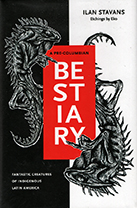 author: Ilan Stavanas
author: Ilan Stavanas
artist: Eko
cover artist: Eko
publisher: The Pennsylvania State University Press
publication date: 2020
cover: harcover with dustjacket
number of pages: 104
ISBN-10: 0-271-08787-0
ISBN-13: 978-0-271-08787-0
description: This volume contains descriptions of forty-six fantastic beasts from indigenous peoples of the Americas.
Our featured entry from this bestiary is the huexólotl.
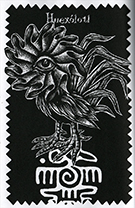 Huexólotl
Huexólotl
(weh-KSOH-loh-tl, Aztec)
Known for eating shadows, Huexólotl (also spelled
Huezólotl) is a rooster with an enormous head composed
of a flower with an eye in the center. Guatemalan poet
Humberto Ak'abal describes it thus in In the Language of
Kings: An Anthology of Mesoamerican Literature, Pre-Columbian
to the Present, edited by Miguel Leon-Portilla and Earl
Shorris (2001):
I walked all night
in search of my shadow.
Huezólotl,
you eat darkness.
Utiwwwwww ...
a coyote.
Tu tu tukuuuuuurr ...
an owl.
Sotz', sotz', sotz' ...
a bat chewing the ear
of a little pig.
Huezólotl, you took away my shadow.
Who am I now?
|
|
|
|
|
Continue to 2023 entries.
|
|
|
|
|
|
|
|

